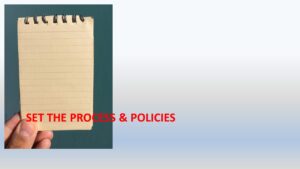Abstract
Entire World spent a challenging year 2020 under pandemic situation. The threat is not yet over with Wave 2 making the life more worse. However, the lull between first wave and second wave provided opportunity to do the things better.
What is the best way other than leveraging the lessons learnt in the last year?
In this article, the author wants to share the observations and learnings that helped set the Process and policies to accommodate IT Project execution fully from remote. The remote execution had to be performed from large number of isolated locations of each member.
Set your Processes and Policies

While moving to new Working Model, You need to ensure there are no apprehensions, no ambiguities to all the Project members from Service Provider and Customer organization. You will have to revisit the current Processes and policies and revise them where necessary and add a few policies if relevant.
While the author can not list all the cases of policy and process changes required, a few typical cases are presented here.
Attendance system:
Every organization has own mechanism(s) to record attendance of their employees, contractors and other stakeholders. In many cases the attendance has a direct relation with compensation. If you are paying the contractor on hourly wages, the “productive” hours spent by each worker are to be tracked. Such attendance is documented on daily basis by the worker as well as the Supervisor of paying organization. The confirmation of hours will also go through well defined approval process. You might have set the exceptions to these approval processes to handle deviations.
Automated systems
Many Organizations perform similar tracking of their own full time employees as well along with Contracted workers. While this process too has approval and exception processes in place, the severities are different.
For example, instead of reducing the compensation the employee may be asked to apply leave. The manager or other designated authority will have discretion to decide the time and need to apply leave.
There are cases when this entire system is automated. The Organization may incorporate sophisticated systems to capture attendance. These systems may offer provisions to enter the IN and OUT timings of each employee as well as Contracted workers. Organization issues each person, a special card. The person needs to swipe this case at the time of entry and exit to record the hours.
Some organizations even went a bit ahead and track the amount hours spent in front of the Computer through mouse movements.
A few more started using facial recognition to track the IN and OUT timings in place of cards. This was because some colleagues may abuse cards provide proxy attendance to others.
When employees stop going to office this attendance system will not work. You need to ensure the the change in the working model does not impact the compensations due to the change in the working model. You need to immediately ensure uninterrupted compensation by quickly establishing new process and policies. Because compensation will be the biggest concern especially when the threat is on economy.
Organization Asset Usage:
The employees and some contracted workers may be using Organization assets such as:
-
-
- Laptops,
- VPN tokens,
- Data Cards for Internet access,
- Multi-Media Projectors
- Specially designed desktops to perform performance heavy activities such as Engineering drawings
-
Organization allows you to use these assets at home for a limited time as per the policy. For example, you may use Company laptop in the Office network on daily basis. The process allows to work from home only a few days usually for not more than 3 days a month. Organization still restricts even this duration and want your manger to provide approval every time.
You need to change the policy to accommodate usage of assets for entire period of Pandemic. In addition, Organization needs to document and share the Do’s and Dont’s of using such assets at home for more than 3 days (in fact for a long term). If required, You will impose certain restrictions in the assets to prevent the possible malpractice. These guidelines must also include additional lines based on Customer’s specific inputs. For example, one customer has sensitive content and hence doesn’t want the holder of assets to have access to Internet. Customer may allow access only to customer’s systems through restricted path. Some customers insist to disable local storage of Laptop or equivalent systems.
Some Guidelines
The lessons learnt based on experience during Wave 1, also lead to new decisions such as
-
-
- Usage of assets such as Chromebooks in place of your regular laptops or tablets.
- Adopt remote desktop that locks the system to target (Customer) network and does not let the screen change to other windows
- It is technically possible to scan the remote worker through camera and freeze the system from remote.
- You may incorporate mechanisms to remotely capture the screen every 5-10 seconds to track any malpractices. This is Similar to a typical model adopted for Remotely held Professional certification exams.
-
-
-
- Service Provider can use scanning applications on regular basis to trace any unwanted entities in the Laptops used by remote workers
-
Waiting for what?
The author provided a few examples on how and where you may verify the policies and processes , modify and publish them.
What are all other preparations that you need if you have to execute projects fully from remote in a typical pandemic kind of scenario?
What learnings of previous year can you adopt?
You may get to know through the UDEMY Course SAP ERP Implementation Fully from Remote (Experience Sharing)
You may check for special prices at the page Special offers


